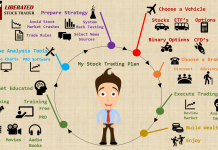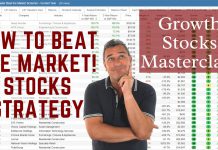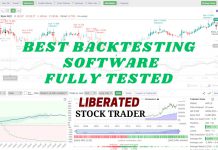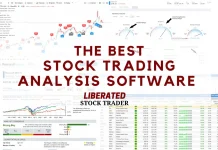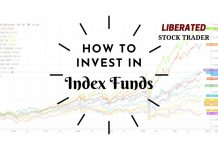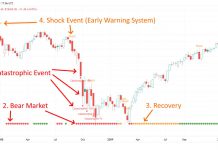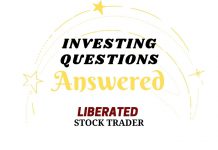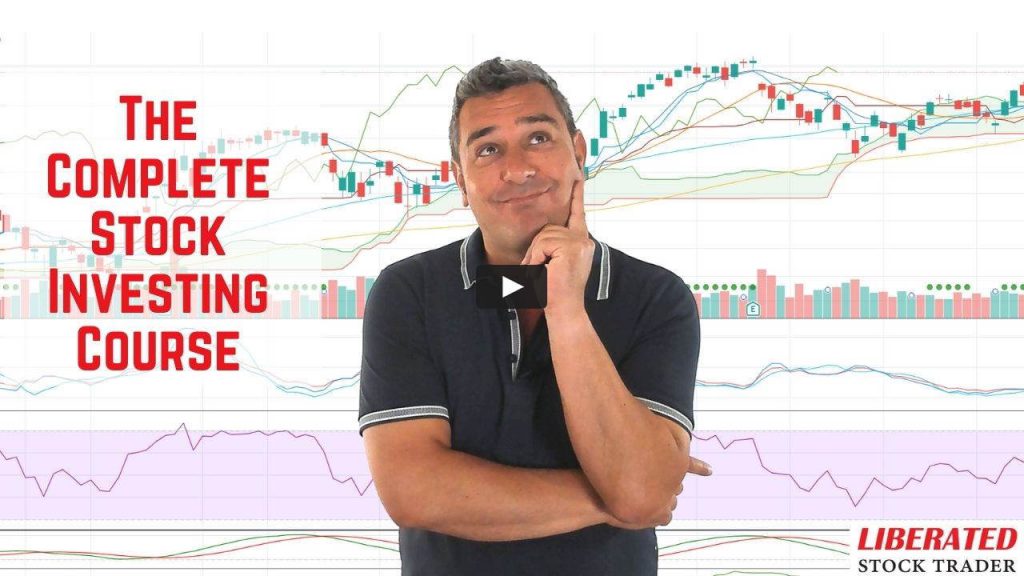When choosing a stock investing training course, you must consider content quality, the instructor’s experience, and industry certification as paramount. Additionally, cost and location should play a role in your decision.
☆ Research You Can Trust ☆
My analysis, research, and testing stems from 25 years of trading experience and my Financial Technician Certification with the International Federation of Technical Analysts.
For financial industry-certified education and instruction, we highly recommend the IFTA Certified Financial Technician (CFTe) and Certified Market Technician (CMT). Courses taught by Certified Financial Technicians include the Liberated Stock Trader Pro, MOSES, and LST Beat the Market.
There are many low-quality, scammy, high-cost stock trading courses out there, and ultimately, anything costing more than one thousand dollars is not worth it.
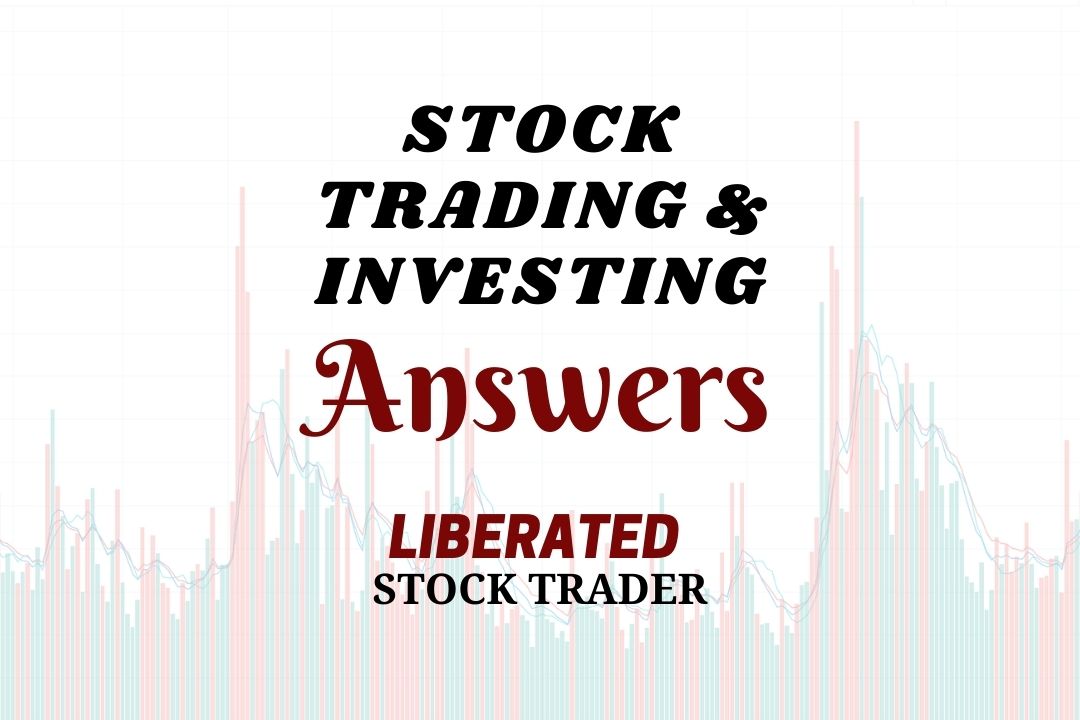
How to choose the perfect investing course
- Consider your goals. What do you hope to achieve by taking a stock market training course? Look for a course covering investment theory and analysis to improve your investment strategies.
- Consider your level of experience. Are you a beginner or a seasoned investor? Choose a course that’s appropriate for your level of experience.
- Consider the type of instruction. Some courses offer classroom-based instruction, while others are self-paced online courses. Decide which type of instruction is best for you. Additionally, verify if your instructors have real-world experience and are professionally certified financial advisors or certified financial markets analysts.
- Consider the cost. Stock market training courses can cost from a few hundred dollars to several thousand dollars. Choose a course that’s affordable for you.
| Stock Trading Training | Region | Online | Onsite | Cost | Industry Certificate | Certified Trainer |
| Liberated Stock Trader Pro | Global | ✔ | ☓ | $299 | ☓ | ✔ |
| CMT Certified Market Technician | USA | ☓ | ✔ | $2,910* | ✔ | ✔ |
| IFTA Certified Financial Technician | Europe/Asia | ☓ | ✔ | $1,400* | ✔ | ✔ |
| Online Trading Academy | USA | ✔ | ✔ | $7,000 | ☓ | ? |
*Textbooks not included (add $300)
What should a good stock market course include?
A good stock market course should include an overview of how the stock market works, an introduction to different types of securities and investments, and a discussion of risk management and diversification. It should also cover basic concepts such as supply and demand, price discovery, and market efficiency.
5 Certified Investing & Trading Courses
We recommend five investment courses, the IFTA Certified Financial Technician (CFTe) and Certified Market Technician (CMT), for financial industry certification. The Liberated Stock Trader Pro, MOSES, and LST Beat the Market courses are taught by a Certified Financial Technician.
1. Certified Financial Technician (CFTe)
The International Federation of Technical Analysts (IFTA) Certified Financial Technician (CFTe) Training Course is an in-depth program designed to equip individuals with the necessary skills and knowledge for a career in financial technical analysis.
The CFTe Training Course is divided into two levels, each offering a unique blend of theoretical knowledge and practical skills:
- Level I: This level covers the basic principles of technical analysis, chart patterns, trend analysis, and technical indicators.
- Level II: The second level delves deeper into advanced technical analysis techniques, including Elliott Wave Theory, Gann, and inter-market analysis.
| CFTe Training Course | Details |
| ⚡ Features | Charts, Indicators, Patterns, Asset Management, Volatility |
| 🏆 Unique Features | Market Cycles, Strategy, Stocks, Bonds, Futures |
| 🎓 Certification | ✔ CFTe |
| 🎯 Best for | Stock, Bonds, Fx & Futures Traders |
| 📅 Duration | 1-Year |
| 🎮 Online | ✔ |
| 🙋 Classroom | ✔ |
| 💰 Price | $850-$1,150 |
| 🌎 Region | Europe/Asia |
Value Proposition
The CFTe Training Course provides:
- A globally recognized certification that enhances credibility in the financial industry.
- In-depth knowledge and skills in technical analysis are essential for various finance roles.
- A strong foundation for those aspiring to pursue the more advanced Master of Financial Technical Analysis (MFTA) certification.
Course Description
The IFTA Certified Financial Technician (CFTe) Training Course is a valuable investment for those seeking to enhance their technical analysis skills. Its comprehensive curriculum, practical approach, and globally recognized certification offer a solid foundation for a successful career in finance.
I am a certified CFTe, and this training course and the certification exams taught me a lot. Not only did the course help me gain skills in technical analysis, but it also gave me a deeper understanding of market dynamics and charting techniques. With this knowledge and experience, I can confidently apply my acquired skills to real-world situations.
I highly recommend taking this IFTA Certified Financial Technician (CFTe) Training Course if you are serious about making a career in the finance industry. The course provides a comprehensive introduction to technical analysis and trading. It covers everything from charting patterns, indicators, and risk management strategies to portfolio diversification and money management techniques. Moreover, you will also get access to one-on-one tutoring sessions with a CFTe professional to help you understand concepts more deeply and apply them in practice.
2. Certified Market Technician (CMT)
The Certified Market Technician (CMT) Training Course, regulated by the Chartered Market Technician Association, USA, is a meticulous program designed to enhance technical analysis skills. It is geared towards individuals venturing into research, portfolio management, hedge fund management, and investment advising.
| CMT Training Course | Details |
| ⚡ Features | Charts, Indicators, Patterns, Risk Management, Volatility |
| 🏆 Unique Features | Market Cycles, System Development |
| 🎓 Certification | ✔ CMT |
| 🎯 Best for | Stock, Fx & Crypto Traders |
| 📅 Duration | 1-Year |
| 🎮 Online | ✔ |
| 🙋 Classroom | ✔ |
| 💰 Price | $1,200-$4,900 |
| 🌎 Region | North America |
Course Content
Divided into progressive levels, the CMT course covers a vast array of topics in technical analysis. Here are the key elements you can expect:
- A detailed official guide and study materials to prepare you for the examination.
- A thorough exploration of technical analysis theories and principles.
- Hands-on experience with various technical analysis tools and techniques.
The Value Proposition
The CMT course offers practical, actionable knowledge that many professionals have found more applicable than much of the CFA curriculum. It’s often cited for its professional relevance and potential career benefits.
The CMT course is also an important step towards developing a career in finance, as it provides the skills and knowledge to assess markets confidently. With this certification, you can work independently in various financial roles such as search, portfolio management, hedge fund management, and investment advising.
You can expect to gain extensive experience and demonstrate your proficiency in technical analysis, charting, and trading strategy. In addition, you will receive training in several areas, such as portfolio management, risk management, quantitative analysis, and financial modeling.
The CMT course is designed for beginners and experts to provide helpful guidance on properly using technical analysis tools and techniques. Through its extensive coverage, ranging from fundamental concepts to advanced strategies, this resource encapsulates the entire spectrum of investment knowledge with utmost clarity. Along with video tutorials and instructor-led classes, you will gain invaluable insights from experienced professionals who know what it takes to manage portfolios and investments successfully.
At the end of this course, you will thoroughly understand technical analysis and its application in different financial products such as stocks, bonds, commodities, and currencies. You can also make informed decisions on when to enter and exit the markets to maximize your returns with minimal risk. By mastering technical analysis tools, you will become an expert at spotting trends in the financial markets and making sound investment decisions.
While individual experiences may vary, most candidates find the course enriching and beneficial. One user shared their positive experience, asserting that the value derived from the course largely depends on one’s perspective.
In conclusion, the Certified Market Technician (CMT) Training Course is a valuable addition to the repertoire of those interested in financial technical analysis. It provides a comprehensive body of knowledge, equipping learners with the necessary tools to succeed in their respective fields.
3. Liberated Stock Trader Pro
Our Liberated Stock Trader Pro stock market course will teach you everything from the basics of reading charts, analyzing price movements, and mastering market fundamentals. It is designed for beginners who want a strong foundation in investing and trading, and it also has valuable insights for experienced traders looking to improve performance!
| LST Pro Training Course | Details |
| ⚡ Features | Charts, Indicators, Patterns, Value, Growth, Dividend Investing |
| 🏆 Unique Features | System & Strategy Development, Data Proven Techniques |
| 🎓 Certification | ☓ |
| 🎯 Best for | Stock Investors & Traders |
| 📅 Duration | 16 Hours |
| 🎮 Online | ✔ |
| 🙋 Classroom | ☓ |
| 💰 Price | $299 |
| 🌎 Region | Global |
The Liberated Stock Trader Pro Training Course is a specialized online program designed to equip participants with the necessary skills and knowledge for successful stock market trading. Taught by a professionally certified market analyst, this comprehensive course covers technical and fundamental analysis, providing a holistic understanding of the stock market landscape.
Try the Liberated Stock Trader Course
Key Elements of the Course Content
The course content is multifaceted, covering a wide range of crucial topics:
- Analytical Framework: The course teaches participants the principles of technical and fundamental analysis.
- Investment Strategies: Participants are introduced to various investing strategies such as dividends, value, and growth.
- Stock Charts: Lessons on reading stock charts, trendlines, and patterns are included.
- Indicators and Volume Analysis: The course covers stock chart indicators and volume analysis.
- Market Sentiment and Trading Psychology: Participants learn about investor sentiment and trading psychology.
- Practical Trading: The course includes practical lessons on buying and selling stocks for profit.
- Personalized System: Participants are guided in creating a personalized stock investing and trading system.
Value Proposition
The Liberated Stock Trader Pro Training Course offers a comprehensive learning experience, equipping participants with the necessary tools to navigate the stock market. Customers have given positive reviews for the course, highlighting its practicality, comprehensiveness, and the instructor’s professionalism.
The Liberated Stock Trader Pro Training Course offers a comprehensive and robust curriculum that prepares individuals for successful stock market trading. Its focus on technical and fundamental analysis and practical lessons on various investing strategies make it a valuable resource for anyone looking to enhance their trading skills.
You want to be a successful stock investor but don’t know where to start.
Learning stock market investing on your own can be overwhelming. There’s so much information out there, and it’s hard to know what’s true and what’s not.
Liberated Stock Trader Pro Investing Course
Our pro investing classes are the perfect way to learn stock investing. You will learn everything you need to know about financial analysis, charts, stock screening, and portfolio building so you can start building wealth today.
★ 16 Hours of Video Lessons + eBook ★
★ Complete Financial Analysis Lessons ★
★ 6 Proven Investing Strategies ★
★ Professional Grade Stock Chart Analysis Classes ★
4. MOSES: ETF Investing Strategy
A stock market investing course designed to teach you how to invest safely and minimize your risk while maximizing profits. The Market Outperforming Stock ETF Strategy (MOSES) lets you invest your capital securely while avoiding stock market crashes.
| MOSES Training Course | Details |
| ⚡ Features | Complete Long-Term ETF Investing Strategy |
| 🏆 Unique Features | Avoid Crashes, Invest in Early Bull Markets |
| 🎓 Certification | X |
| 🎯 Best for | Long-term Investors |
| 📅 Duration | 3 Hours |
| 🎮 Online | ✔ |
| 🙋 Classroom | X |
| 💰 Price | $299 |
| 🌎 Region | Global |
The MOSES Investing Training Course is a comprehensive program offered by Liberated Stock Trader, a platform committed to unbiased investing education. It is designed to provide investors with practical knowledge and tools to navigate the stock market effectively. Barry D. Moore, a certified financial technician, created the course.
Course Content
- An in-depth understanding of the MOSES ETF Investing Strategy, a method designed to improve performance and lower risk.
- Insights into how MOSES outperforms major stock market indices.
- Detailed explanations of the five core indicators MOSES uses to navigate stock market crashes.
- MOSES provides information on buy and sell alerts.
- A deep dive into three proven and backtested high-performance investing strategies MOSES offers.
Value Proposition
The MOSES Investing Training Course offers several benefits:
- It’s fully automated and integrated into TradingView.
- It has been tested and proven to detect crashes, helping investors avoid significant losses and reallocate capital into safer investments.
- It provides investors with alerts before the next crash happens.
- It’s designed to work on large index-tracking ETFs.
- It provides different buy and sell alerts depending on the chosen strategy.
- It comes with a 7-module video training course and eBook.
- MOSES has been backtested since 1927 and has shown profitable results.
The MOSES Investing Training Course is an invaluable resource for investors looking to enhance their investing strategies and tools. Its focus on practical methods, combined with the expert guidance of a certified financial technician, makes it a must-have for individuals aiming for successful investing.
5. Beat the Market: Growth Stock Masterclass
The Liberated Stock Trader Beat The Market (LST BTM) growth stocks strategy identifies the 35 best stocks to buy with a significant chance of beating S&P 500 returns. We use free cash flow and explosive EPS growth combined with Joel Greenblatt’s ROC Magic Formula and William J O’ Neil’s CANSLIM method elements. These factors have let us beat the market 8 out of the last nine years!
| LST BTM Training Course | Details |
| ⚡ Features | Proven Growth Stock Investing Strategy |
| 🏆 Unique Features | 35 Stocks Every Month, Market Outperformance 8 of 9 Years |
| 🎓 Certification | X |
| 🎯 Best for | Stock Investors |
| 📅 Duration | 3 Hours |
| 🎮 Online | ✔ |
| 🙋 Classroom | X |
| 💰 Price | $299 |
| 🌎 Region | North America |
Liberated Stock Trader’s “Beat the Market System” robust trading strategy consistently outperforms key stock indices. This system focuses on selecting financially sound, high-growth stocks and has proven its effectiveness over the last nine years.
Try The Beat the Market Course
Key Features of the System
- High Performance: The system has outperformed the S&P 500 by 102% over nine years, delivering a total return of 546%, compared to the S&P 500’s 219%.
- Consistent Results: The strategy has beaten the market in eight of the last nine years. In 2020, it returned 51.8%, and in 2019, it provided a return of 46.8%, outperforming the S&P 500 by 17.9%.
- Stock Selection: The system selects 35 high-growth stocks that are financially healthy and have already outperformed the S&P 500 in the trailing 12 months.
- Criteria: The system uses growth in free cash flow and explosive EPS growth as key indicators for stock selection.
- Portfolio Growth: The strategy turned an investment of $100,000 into $645,706 over nine years.
- Guarantee: The strategy has a 90-day money-back guarantee, underscoring its reliability.
The Liberated Stock Trader “Beat the Market System” is a proven and reliable strategy for investors seeking to outperform the market. Its focus on financially healthy, high-growth stocks and impressive track record make it an invaluable tool for individuals looking to optimize their trading strategies.
9 Topics Good Stock Investing Courses Should Cover
- What Moves Stock Markets? Several factors can move stock markets, including economic data, company earnings, and global events. The business cycle is a fundamental driver of stock market movements. In general, stocks do well when the economy grows and corporate profits rise. On the other hand, when the economy is contracting and companies are reporting declining profits, stock prices will usually fall.
- Stock Market Financial Analysis. Stock market financial analysis is the study of a company’s financial statements to understand its overall financial health and performance better. This type of analysis can be used to make investment decisions and assess the risks and opportunities associated with a particular stock.
- Dividend Investing. Dividend investing is a great way to make money. You can invest in stocks that pay dividends and make a lot of money. However, you need to be careful with this type of investing. You must ensure that you invest in stable companies with a good history of paying dividends.
- Growth Investing. Growth investing is an investment strategy focusing on companies with strong growth prospects. Growth investors look for companies growing faster than their peers and are expected to continue doing so. One of the main advantages of growth investing is that it can help investors maximize their returns.
- Value Investing. Value investing is an investment strategy focusing on buying stocks trading at a discount to their intrinsic value. Intrinsic value is a company’s true underlying value, which may differ from its market value. Value investors believe that by paying less than the intrinsic value of a stock, they are getting a bargain, which the market will eventually recognize.
- Stock Screening Strategies. Investors always look for stocks trading at a discount or experience great price growth. However, finding these stocks can be a challenge. One way to find potential candidates is to screen for stocks using specific criteria. By doing this, you can narrow the universe of stocks to a more manageable number.
- Trading Stocks Using Stock Charts & Indicators. Investors and traders should learn how to read stock charts and use indicators. By learning how to do this, you can make better investment decisions and trade stocks more effectively. You may wonder how to trade stocks using stock charts if you’re new to the stock market. Stock charts are a graphical representation of a stock’s price history and can provide valuable insights into a stock’s past performance and prospects.
- Stock Market Investing Sentiment Indicators. Stock market sentiment indicators are tools that investors use to gauge the mood or underlying psychology of the market. By tracking various sentiment indicators, investors can better understand whether the market is optimistic or pessimistic about a particular security or group of securities.
- How to Create a Stock Investing Strategy. There are several ways to approach stock investing, and your chosen strategy will ultimately depend on your individual goals and risk tolerance. However, regardless of your strategy, there are some basic steps you’ll need to follow to succeed.
Are stock market trading courses worth it?
Yes, stock market trading courses can be a valuable resource for learning the basics of investing and how to develop sound strategies. However, it is important to avoid overhyped courses that promise get-rich-quick riches and cost thousands of dollars. If a training course features Lamborghinis, Rolexes, and flashes of wealth and money, avoid it at all costs.
Stock trading courses can be a helpful way to learn about the market and how to trade stocks. However, it is important to remember that there is no guarantee that you will make money by taking a course. It is also important to carefully research any courses you are considering before signing up.
Alternatively, you can teach yourself with various free and low-cost training methods.



